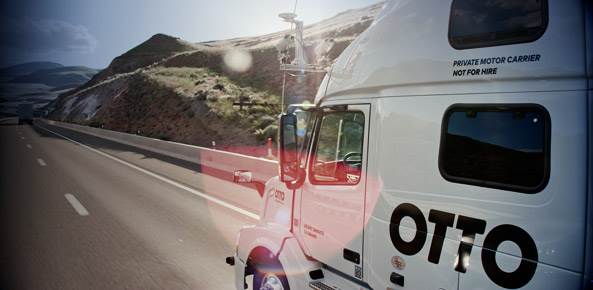
Otto, the self-driving truck startup that was acquired by Uber for $700 million, has just completed the world’s first completely autonomous commercial freight delivery.
In partnership with Anheuser-Busch, Otto shipped 45,000 Budweisers 120 miles from the company’s facility in Loveland, Colo., to a weigh station in Fort Collins.
Though there was a professional driver in the truck the entire time, he never had to intervene and the truck was able to drive itself from exit to exit, according to the company. The software is programmed to hand off control to the human driver when the truck needs to exit the freeway.
“By embracing this technology, both organizations are actively contributing to the creation of a safer and more efficient transportation network,” Otto co-founder Lior Ron said in a statement. “We are excited to have reached this milestone together, and look forward to further rolling out our technology on the nation’s highways.”
It’s the first trip of its kind. While several companies — including Otto — have completed numerous fully autonomous trips along freeways, no one had completed an autonomous commercial delivery.
That means, though several sources pegged Uber’s acquisition of Otto as mostly an “acqhire” of Otto’s team, specifically co-founder Anthony Levandowski, Uber is now growing more serious about the trucking business. It’s a smart move for the company, which has worked to diversify its revenue streams with on-demand delivery and B2B services in an increasingly crowded ride-hail market.
The partnership just covers this single pilot trip, for which Anheuser-Busch paid Otto $470, so it’s not the partnership itself that’s significant. But rather that Otto’s autonomous technology, at least, is close to being market-ready.
This rush-to-market approach is true to the DNA of Otto, a now barely one-year-old company.
Otto’s founders – Ron, Levandowski, Don Burnette, and Claire Delaunay – are former Google veterans who worked on everything from maps to the self-driving car project. In fact, Levandowski was one of the original members of Google’s self-driving team.
As of its initial launch in May of 2016, the company’s ambitions were clear: The team was intent on bringing self-driving technology to market as fast as possible. Call it a reaction to working at a company that has yet to ship a product in spite of working on the technology for close to eight years.
That’s why the company decided to go into trucking. Trucks largely operate on freeways – an environment in which many companies, including Google, have mastered driving autonomously to a degree – and thus it is faster to develop and deploy the technology in trucks than it would be in passenger cars meant to navigate city streets.
Now, fresh off being acquired by Uber, Otto is moving quickly to commercialize its technology. The company has already begun ramping up its on-demand logistics service for trucks, called UberFreight. Essentially, the way it will work is Otto, care of Uber, will match either independent drivers or fleet managers who have room on their trucks with freight that needs to be shipped.
A trademark filing describes UberFreight as a “freight brokerage service” that also includes “[hardware and software] units for automated and semi-automated driving of vehicles” and “leasing of vehicles and trailers.”
Based on this description, it seemed likely that Otto will simply be known as UberFreight going forward because the trademark Otto filed in March 2016 was nearly identical. But the company says the service itself will be called UberFreight while the trucks will be under the Otto name.
According to Ron — who spoke to Recode on a recent visit to the company’s headquarters in San Francisco — though the company may be working closely with Uber on ramping up the freight matching platform, Otto has remained largely independent.
That’s because beyond some of the fundamental aspects of the technology, little about Uber X and UberPool translates directly to Otto’s business. Instead, Levandowski has taken control of Uber’s self-driving operations while also helping to manage Otto.
However, honing an on-demand platform – like honing self-driving technology – is no easy task. Just ask Uber, which has been working on improving its software since 2009.
For now, UberFreight will launch as a two-sided marketplace for truck drivers and freight needing to be shipped, without much of the autonomous technology. Think of it as the same path that Uber took to perfect its technology for its traditional services – establishing both supply and demand and smoothing out the routing algorithms – before beginning its foray into self-driving cars.
But UberFreight won’t be the only “Uber for trucking” company on the road. Several companies attempting to solve the same logistical dilemma have sprung up, including Convoy, which has so far raised close to $19 million in funding.
When asked about competing with Uber, Convoy co-founder and CEO Dan Lewis said: “It will be interesting to see how Uber will use Otto’s self-driving technology. Convoy focuses on building great relationships with trucking companies and drivers, many of whom are also exploring emerging self-driving solutions. We are evaluating these options, among others, and we continue to use technology to improve our experience for shippers and carriers.”
From ramping up and launching the fledgling version of UberFreight to finding partners and suppliers to manufacture the hardware which the company builds in-house for now, there is still a lot to be done before Otto or UberFreight becomes a full-fledged commercial self-driving service.
© 2016 Re/Code under contract with NewsEdge. -.







